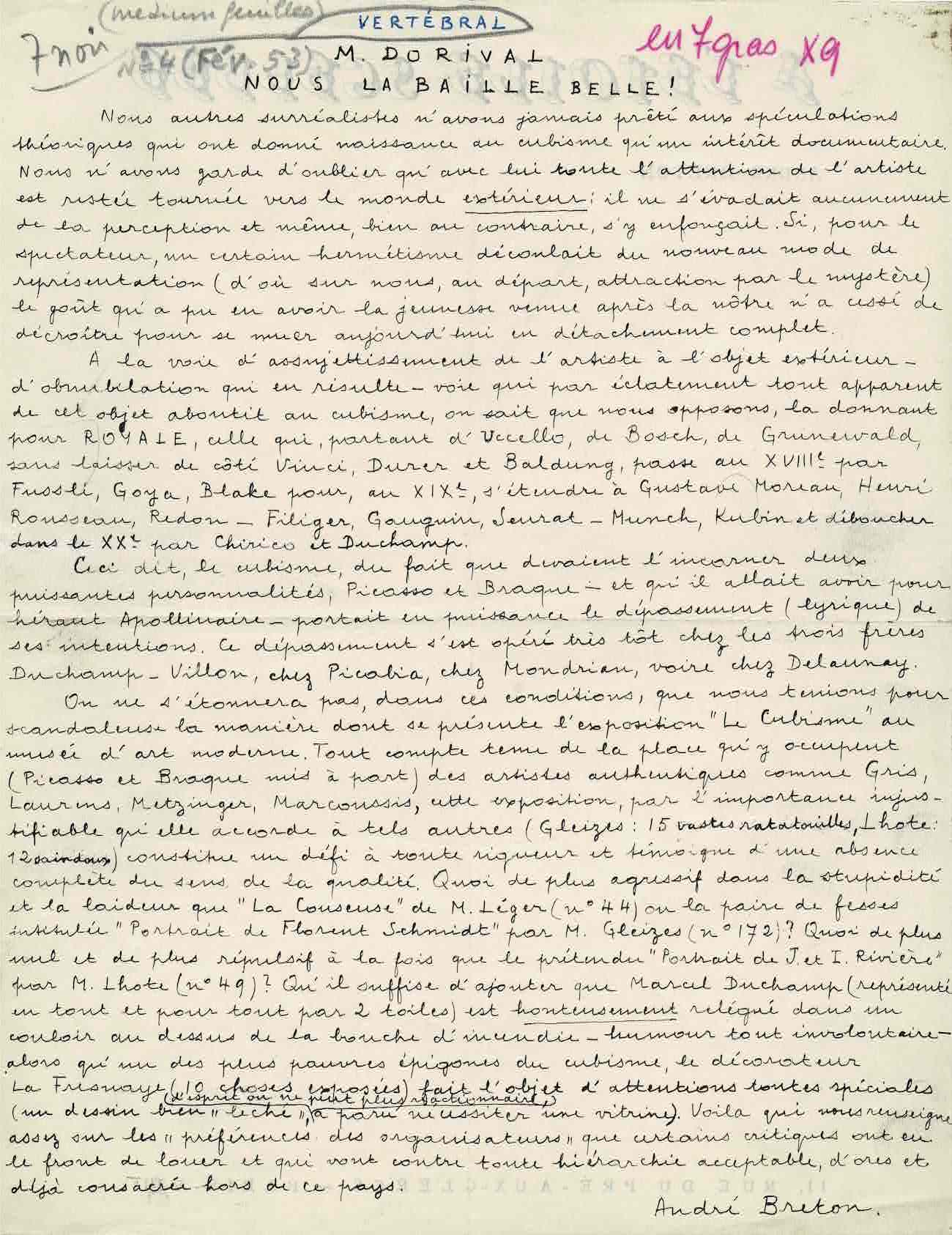André Breton (1896.1966).
Autograph manuscript signed – M. DORIVAL WE LOVE IT!
A large octavo page on the back of a sealed star
Undated (February 1953)
“It will come as no surprise that we consider the way in which the “Cubism” exhibition at the Museum of Modern Art is presented as scandalous. »
Breton vehemently criticizes the exhibition on Cubism at the Museum of Modern Art. This text appeared in the Medium magazine, Surrealist Information , in February 1953.
“ We surrealists have never given the theoretical speculations which gave birth to Cubism more than a documentary interest . We are careful not to forget that with him all the artist's attention remained turned towards the outside : he in no way escaped perception and even, quite the contrary, sank into it. If, for the spectator, a certain hermeticism resulted from the new mode of representation (hence on us, at the beginning, attraction by the mystery) the taste that the youth who came after ours may have had has continued to decrease to turn today into a complete detachment.
To the path of subjugation of the artist to the external object - of the obnubilation which results from it - a path which by completely apparent explosion of this object leads to cubism, we know that we oppose, giving it as ROYAL, the one which, starting from Uccello, Bosch, Grünewald, without leaving aside Vinci, Durer, and Baldung, passes in the 18th century through Fussli, Goya, Blake to, in the 19th century, extend to Gustave Moreau, Henri Rousseau, Redon, Filiger, Gauguin, Seurat, Munch, Kubin and leading into the 20th century through Chirico and Duchamp.
That said, Cubism, in fact which was to be embodied by two powerful personalities, Picasso and Braque – and which it was to have as its herald Apollinaire – carried with it the potential (lyrical) surpassing of its intentions. This overtaking took place very early on among the three Duchamp brothers – Villon, at Picabia, at Mondrian, and even at Delaunay.
It will come as no surprise, in these conditions, that we consider the manner in which the exhibition “Cubism” at the Museum of Modern Art is presented as scandalous . Taking into account the place occupied (Picasso and Braque aside) by authentic artists like Gris, Laurens, Metzinger, Marcoussis, this exhibition, by the unjustifiable importance it grants to such others (Gleizes: 15 ratatouille vases, Lhote: 12 lard) constitutes a challenge to all rigor and demonstrates a complete absence of a sense of quality. What could be more aggressive in stupidity and ugliness than “La Couseuse” by M. Léger (n°44) or the pair of buttocks entitled “Portrait of Florent Schmidt” by M. Gleizes (n°172)? What could be more worthless and more repulsive at the same time than the so-called “Portrait of J. and I. Rivière” by M. Lhote (n°49)? Suffice it to add that Marcel Duchamp (represented in totality by 2 paintings) is shamefully relegated to a corridor above the fire hydrant – entirely unintentional humor – while one of the poorest epigones of the cubism, the decorator La Fresnay (10 things on display) is the subject of very special attention (a well-polished drawing, which could not be more reactionary in spirit, seemed to require a window). This tells us enough about the preferences of the organizers that some critics have had the courage to praise and which go against any acceptable hierarchy, already established outside this country. André Breton. »
Bibliography: André Breton (Edition by Marguerite Bonnet with the collaboration of Philippe Bernier, Marie-Claire Dumas, Étienne-Alain Hubert and José Pierre), ““Medium, Surrealist Information” (notes)”, Alentours II, Complete Works , volume III , Bibliothèque de la Pléiade, Paris, Gallimard, 1999, p. 1085-1087, notice p. 1461-1462

